Microsoft DP-200 Exam Practice Questions (P. 2)
- Full Access (372 questions)
- Six months of Premium Access
- Access to one million comments
- Seamless ChatGPT Integration
- Ability to download PDF files
- Anki Flashcard files for revision
- No Captcha & No AdSense
- Advanced Exam Configuration
Question #11
You are the data engineer for your company. An application uses a NoSQL database to store data. The database uses the key-value and wide-column NoSQL database type.
Developers need to access data in the database using an API.
You need to determine which API to use for the database model and type.
Which two APIs should you use? Each correct answer presents a complete solution.
NOTE: Each correct selection is worth one point.
Developers need to access data in the database using an API.
You need to determine which API to use for the database model and type.
Which two APIs should you use? Each correct answer presents a complete solution.
NOTE: Each correct selection is worth one point.
- ATable API
- BMongoDB API
- CGremlin API
- DSQL API
- ECassandra API
Correct Answer:
BE
B: Azure Cosmos DB is the globally distributed, multimodel database service from Microsoft for mission-critical applications. It is a multimodel database and supports document, key-value, graph, and columnar data models.
E: Wide-column stores store data together as columns instead of rows and are optimized for queries over large datasets. The most popular are Cassandra and
HBase.
References:
https://docs.microsoft.com/en-us/azure/cosmos-db/graph-introduction https://www.mongodb.com/scale/types-of-nosql-databases
BE
B: Azure Cosmos DB is the globally distributed, multimodel database service from Microsoft for mission-critical applications. It is a multimodel database and supports document, key-value, graph, and columnar data models.
E: Wide-column stores store data together as columns instead of rows and are optimized for queries over large datasets. The most popular are Cassandra and
HBase.
References:
https://docs.microsoft.com/en-us/azure/cosmos-db/graph-introduction https://www.mongodb.com/scale/types-of-nosql-databases
send
light_mode
delete
Question #12
A company is designing a hybrid solution to synchronize data and on-premises Microsoft SQL Server database to Azure SQL Database.
You must perform an assessment of databases to determine whether data will move without compatibility issues. You need to perform the assessment.
Which tool should you use?
You must perform an assessment of databases to determine whether data will move without compatibility issues. You need to perform the assessment.
Which tool should you use?
- ASQL Server Migration Assistant (SSMA)
- BMicrosoft Assessment and Planning Toolkit
- CSQL Vulnerability Assessment (VA)
- DAzure SQL Data Sync
- EData Migration Assistant (DMA)
Correct Answer:
E
The Data Migration Assistant (DMA) helps you upgrade to a modern data platform by detecting compatibility issues that can impact database functionality in your new version of SQL Server or Azure SQL Database. DMA recommends performance and reliability improvements for your target environment and allows you to move your schema, data, and uncontained objects from your source server to your target server.
References:
https://docs.microsoft.com/en-us/sql/dma/dma-overview
E
The Data Migration Assistant (DMA) helps you upgrade to a modern data platform by detecting compatibility issues that can impact database functionality in your new version of SQL Server or Azure SQL Database. DMA recommends performance and reliability improvements for your target environment and allows you to move your schema, data, and uncontained objects from your source server to your target server.
References:
https://docs.microsoft.com/en-us/sql/dma/dma-overview
send
light_mode
delete
Question #13
DRAG DROP -
You manage a financial computation data analysis process. Microsoft Azure virtual machines (VMs) run the process in daily jobs, and store the results in virtual hard drives (VHDs.)
The VMs product results using data from the previous day and store the results in a snapshot of the VHD. When a new month begins, a process creates a new
VHD.
You must implement the following data retention requirements:
✑ Daily results must be kept for 90 days
✑ Data for the current year must be available for weekly reports
✑ Data from the previous 10 years must be stored for auditing purposes
✑ Data required for an audit must be produced within 10 days of a request.
You need to enforce the data retention requirements while minimizing cost.
How should you configure the lifecycle policy? To answer, drag the appropriate JSON segments to the correct locations. Each JSON segment may be used once, more than once, or not at all. You may need to drag the split bat between panes or scroll to view content.
NOTE: Each correct selection is worth one point.
Select and Place:
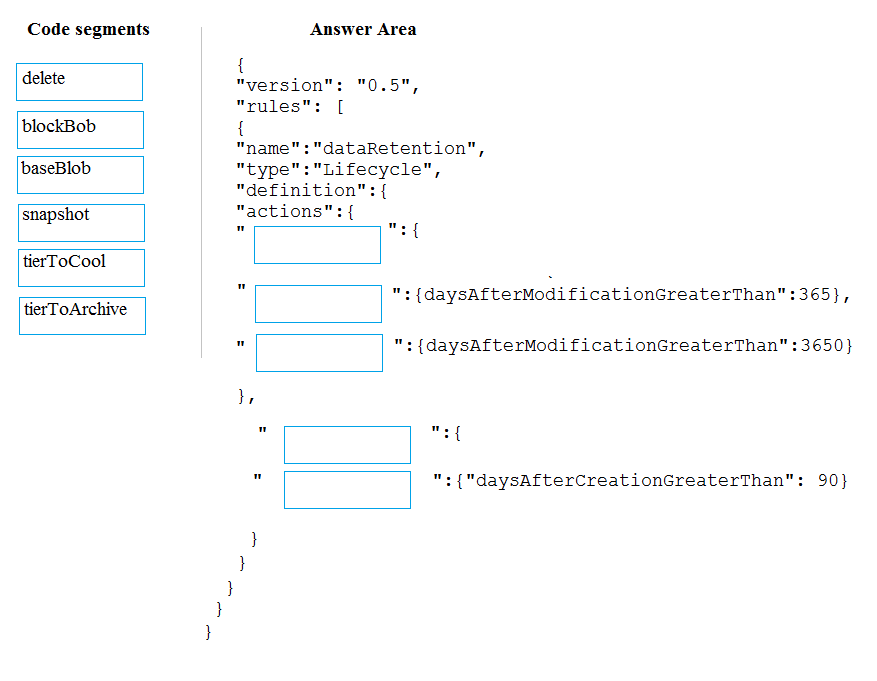
You manage a financial computation data analysis process. Microsoft Azure virtual machines (VMs) run the process in daily jobs, and store the results in virtual hard drives (VHDs.)
The VMs product results using data from the previous day and store the results in a snapshot of the VHD. When a new month begins, a process creates a new
VHD.
You must implement the following data retention requirements:
✑ Daily results must be kept for 90 days
✑ Data for the current year must be available for weekly reports
✑ Data from the previous 10 years must be stored for auditing purposes
✑ Data required for an audit must be produced within 10 days of a request.
You need to enforce the data retention requirements while minimizing cost.
How should you configure the lifecycle policy? To answer, drag the appropriate JSON segments to the correct locations. Each JSON segment may be used once, more than once, or not at all. You may need to drag the split bat between panes or scroll to view content.
NOTE: Each correct selection is worth one point.
Select and Place:

Correct Answer:
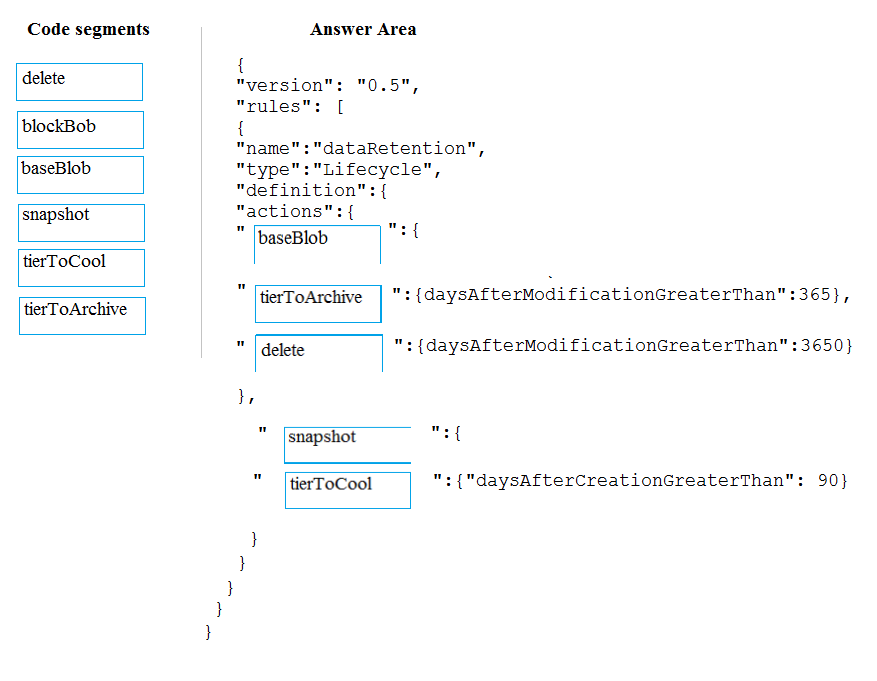
The Set-AzStorageAccountManagementPolicy cmdlet creates or modifies the management policy of an Azure Storage account.
Example: Create or update the management policy of a Storage account with ManagementPolicy rule objects.

Action -BaseBlobAction Delete -daysAfterModificationGreaterThan 100
PS C:\>$action1 = Add-AzStorageAccountManagementPolicyAction -InputObject $action1 -BaseBlobAction TierToArchive -daysAfterModificationGreaterThan 50
PS C:\>$action1 = Add-AzStorageAccountManagementPolicyAction -InputObject $action1 -BaseBlobAction TierToCool -daysAfterModificationGreaterThan 30
PS C:\>$action1 = Add-AzStorageAccountManagementPolicyAction -InputObject $action1 -SnapshotAction Delete -daysAfterCreationGreaterThan 100
PS C:\>$filter1 = New-AzStorageAccountManagementPolicyFilter -PrefixMatch ab,cd
PS C:\>$rule1 = New-AzStorageAccountManagementPolicyRule -Name Test -Action $action1 -Filter $filter1
PS C:\>$action2 = Add-AzStorageAccountManagementPolicyAction -BaseBlobAction Delete -daysAfterModificationGreaterThan 100
PS C:\>$filter2 = New-AzStorageAccountManagementPolicyFilter
References:
https://docs.microsoft.com/en-us/powershell/module/az.storage/set-azstorageaccountmanagementpolicy

The Set-AzStorageAccountManagementPolicy cmdlet creates or modifies the management policy of an Azure Storage account.
Example: Create or update the management policy of a Storage account with ManagementPolicy rule objects.

Action -BaseBlobAction Delete -daysAfterModificationGreaterThan 100
PS C:\>$action1 = Add-AzStorageAccountManagementPolicyAction -InputObject $action1 -BaseBlobAction TierToArchive -daysAfterModificationGreaterThan 50
PS C:\>$action1 = Add-AzStorageAccountManagementPolicyAction -InputObject $action1 -BaseBlobAction TierToCool -daysAfterModificationGreaterThan 30
PS C:\>$action1 = Add-AzStorageAccountManagementPolicyAction -InputObject $action1 -SnapshotAction Delete -daysAfterCreationGreaterThan 100
PS C:\>$filter1 = New-AzStorageAccountManagementPolicyFilter -PrefixMatch ab,cd
PS C:\>$rule1 = New-AzStorageAccountManagementPolicyRule -Name Test -Action $action1 -Filter $filter1
PS C:\>$action2 = Add-AzStorageAccountManagementPolicyAction -BaseBlobAction Delete -daysAfterModificationGreaterThan 100
PS C:\>$filter2 = New-AzStorageAccountManagementPolicyFilter
References:
https://docs.microsoft.com/en-us/powershell/module/az.storage/set-azstorageaccountmanagementpolicy
send
light_mode
delete
Question #14
A company plans to use Azure SQL Database to support a mission-critical application.
The application must be highly available without performance degradation during maintenance windows.
You need to implement the solution.
Which three technologies should you implement? Each correct answer presents part of the solution.
NOTE: Each correct selection is worth one point.
The application must be highly available without performance degradation during maintenance windows.
You need to implement the solution.
Which three technologies should you implement? Each correct answer presents part of the solution.
NOTE: Each correct selection is worth one point.
- APremium service tier
- BVirtual machine Scale Sets
- CBasic service tier
- DSQL Data Sync
- EAlways On availability groups
- FZone-redundant configuration
Correct Answer:
AEF
A: Premium/business critical service tier model that is based on a cluster of database engine processes. This architectural model relies on a fact that there is always a quorum of available database engine nodes and has minimal performance impact on your workload even during maintenance activities.
E: In the premium model, Azure SQL database integrates compute and storage on the single node. High availability in this architectural model is achieved by replication of compute (SQL Server Database Engine process) and storage (locally attached SSD) deployed in 4-node cluster, using technology similar to SQL
Server Always On Availability Groups.
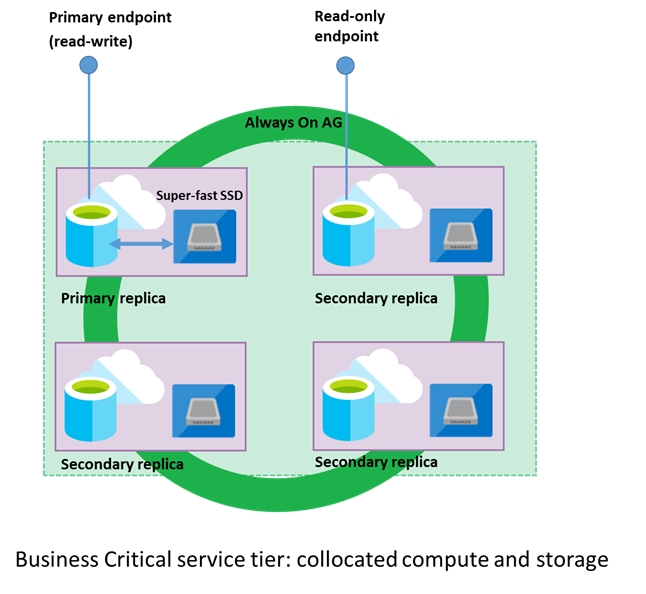
F: Zone redundant configuration -
By default, the quorum-set replicas for the local storage configurations are created in the same datacenter. With the introduction of Azure Availability Zones, you have the ability to place the different replicas in the quorum-sets to different availability zones in the same region. To eliminate a single point of failure, the control ring is also duplicated across multiple zones as three gateway rings (GW).
References:
https://docs.microsoft.com/en-us/azure/sql-database/sql-database-high-availability
AEF
A: Premium/business critical service tier model that is based on a cluster of database engine processes. This architectural model relies on a fact that there is always a quorum of available database engine nodes and has minimal performance impact on your workload even during maintenance activities.
E: In the premium model, Azure SQL database integrates compute and storage on the single node. High availability in this architectural model is achieved by replication of compute (SQL Server Database Engine process) and storage (locally attached SSD) deployed in 4-node cluster, using technology similar to SQL
Server Always On Availability Groups.

F: Zone redundant configuration -
By default, the quorum-set replicas for the local storage configurations are created in the same datacenter. With the introduction of Azure Availability Zones, you have the ability to place the different replicas in the quorum-sets to different availability zones in the same region. To eliminate a single point of failure, the control ring is also duplicated across multiple zones as three gateway rings (GW).
References:
https://docs.microsoft.com/en-us/azure/sql-database/sql-database-high-availability
send
light_mode
delete
Question #15
A company plans to use Azure Storage for file storage purposes. Compliance rules require:
✑ A single storage account to store all operations including reads, writes and deletes
✑ Retention of an on-premises copy of historical operations
You need to configure the storage account.
Which two actions should you perform? Each correct answer presents part of the solution.
NOTE: Each correct selection is worth one point.
✑ A single storage account to store all operations including reads, writes and deletes
✑ Retention of an on-premises copy of historical operations
You need to configure the storage account.
Which two actions should you perform? Each correct answer presents part of the solution.
NOTE: Each correct selection is worth one point.
- AConfigure the storage account to log read, write and delete operations for service type Blob
- BUse the AzCopy tool to download log data from $logs/blob
- CConfigure the storage account to log read, write and delete operations for service-type table
- DUse the storage client to download log data from $logs/table
- EConfigure the storage account to log read, write and delete operations for service type queue
Correct Answer:
AB
Storage Logging logs request data in a set of blobs in a blob container named $logs in your storage account. This container does not show up if you list all the blob containers in your account but you can see its contents if you access it directly.
To view and analyze your log data, you should download the blobs that contain the log data you are interested in to a local machine. Many storage-browsing tools enable you to download blobs from your storage account; you can also use the Azure Storage team provided command-line Azure Copy Tool (AzCopy) to download your log data.
References:
https://docs.microsoft.com/en-us/rest/api/storageservices/enabling-storage-logging-and-accessing-log-data
AB
Storage Logging logs request data in a set of blobs in a blob container named $logs in your storage account. This container does not show up if you list all the blob containers in your account but you can see its contents if you access it directly.
To view and analyze your log data, you should download the blobs that contain the log data you are interested in to a local machine. Many storage-browsing tools enable you to download blobs from your storage account; you can also use the Azure Storage team provided command-line Azure Copy Tool (AzCopy) to download your log data.
References:
https://docs.microsoft.com/en-us/rest/api/storageservices/enabling-storage-logging-and-accessing-log-data
send
light_mode
delete
Question #16
DRAG DROP -
You are developing a solution to visualize multiple terabytes of geospatial data.
The solution has the following requirements:
✑ Data must be encrypted.
✑ Data must be accessible by multiple resources on Microsoft Azure.
You need to provision storage for the solution.
Which four actions should you perform in sequence? To answer, move the appropriate action from the list of actions to the answer area and arrange them in the correct order.
Select and Place:

You are developing a solution to visualize multiple terabytes of geospatial data.
The solution has the following requirements:
✑ Data must be encrypted.
✑ Data must be accessible by multiple resources on Microsoft Azure.
You need to provision storage for the solution.
Which four actions should you perform in sequence? To answer, move the appropriate action from the list of actions to the answer area and arrange them in the correct order.
Select and Place:

Correct Answer:
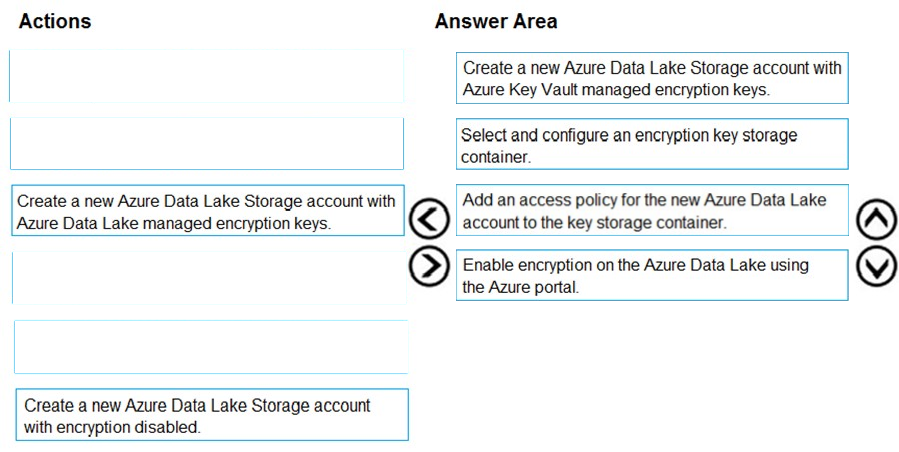
Create a new Azure Data Lake Storage account with Azure Data Lake managed encryption keys
For Azure services, Azure Key Vault is the recommended key storage solution and provides a common management experience across services. Keys are stored and managed in key vaults, and access to a key vault can be given to users or services. Azure Key Vault supports customer creation of keys or import of customer keys for use in customer-managed encryption key scenarios.
Note: Data Lake Storage Gen1 account Encryption Settings. There are three options:
✑ Do not enable encryption.
✑ Use keys managed by Data Lake Storage Gen1, if you want Data Lake Storage Gen1 to manage your encryption keys.
✑ Use keys from your own Key Vault. You can select an existing Azure Key Vault or create a new Key Vault. To use the keys from a Key Vault, you must assign permissions for the Data Lake Storage Gen1 account to access the Azure Key Vault.
References:
https://docs.microsoft.com/en-us/azure/security/fundamentals/encryption-atrest

Create a new Azure Data Lake Storage account with Azure Data Lake managed encryption keys
For Azure services, Azure Key Vault is the recommended key storage solution and provides a common management experience across services. Keys are stored and managed in key vaults, and access to a key vault can be given to users or services. Azure Key Vault supports customer creation of keys or import of customer keys for use in customer-managed encryption key scenarios.
Note: Data Lake Storage Gen1 account Encryption Settings. There are three options:
✑ Do not enable encryption.
✑ Use keys managed by Data Lake Storage Gen1, if you want Data Lake Storage Gen1 to manage your encryption keys.
✑ Use keys from your own Key Vault. You can select an existing Azure Key Vault or create a new Key Vault. To use the keys from a Key Vault, you must assign permissions for the Data Lake Storage Gen1 account to access the Azure Key Vault.
References:
https://docs.microsoft.com/en-us/azure/security/fundamentals/encryption-atrest
send
light_mode
delete
Question #17
You are developing a data engineering solution for a company. The solution will store a large set of key-value pair data by using Microsoft Azure Cosmos DB.
The solution has the following requirements:
✑ Data must be partitioned into multiple containers.
✑ Data containers must be configured separately.
✑ Data must be accessible from applications hosted around the world.
✑ The solution must minimize latency.
You need to provision Azure Cosmos DB.
Which three actions should you perform? Each correct answer presents part of the solution.
NOTE: Each correct selection is worth one point.
The solution has the following requirements:
✑ Data must be partitioned into multiple containers.
✑ Data containers must be configured separately.
✑ Data must be accessible from applications hosted around the world.
✑ The solution must minimize latency.
You need to provision Azure Cosmos DB.
Which three actions should you perform? Each correct answer presents part of the solution.
NOTE: Each correct selection is worth one point.
- AConfigure account-level throughput.
- BProvision an Azure Cosmos DB account with the Azure Table API. Enable geo-redundancy.
- CConfigure table-level throughput.
- DReplicate the data globally by manually adding regions to the Azure Cosmos DB account.
- EProvision an Azure Cosmos DB account with the Azure Table API. Enable multi-region writes.
Correct Answer:
E
Scale read and write throughput globally. You can enable every region to be writable and elastically scale reads and writes all around the world. The throughput that your application configures on an Azure Cosmos database or a container is guaranteed to be delivered across all regions associated with your Azure Cosmos account. The provisioned throughput is guaranteed up by financially backed SLAs.
Reference:
https://docs.microsoft.com/en-us/azure/cosmos-db/distribute-data-globally
E
Scale read and write throughput globally. You can enable every region to be writable and elastically scale reads and writes all around the world. The throughput that your application configures on an Azure Cosmos database or a container is guaranteed to be delivered across all regions associated with your Azure Cosmos account. The provisioned throughput is guaranteed up by financially backed SLAs.
Reference:
https://docs.microsoft.com/en-us/azure/cosmos-db/distribute-data-globally
send
light_mode
delete
Question #18
A company has a SaaS solution that uses Azure SQL Database with elastic pools. The solution will have a dedicated database for each customer organization.
Customer organizations have peak usage at different periods during the year.
Which two factors affect your costs when sizing the Azure SQL Database elastic pools? Each correct answer presents a complete solution.
NOTE: Each correct selection is worth one point.
Customer organizations have peak usage at different periods during the year.
Which two factors affect your costs when sizing the Azure SQL Database elastic pools? Each correct answer presents a complete solution.
NOTE: Each correct selection is worth one point.
- Amaximum data size
- Bnumber of databases
- CeDTUs consumption
- Dnumber of read operations
- Enumber of transactions
Correct Answer:
AC
A: With the vCore purchase model, in the General Purpose tier, you are charged for Premium blob storage that you provision for your database or elastic pool.
Storage can be configured between 5 GB and 4 TB with 1 GB increments. Storage is priced at GB/month.
C: In the DTU purchase model, elastic pools are available in basic, standard and premium service tiers. Each tier is distinguished primarily by its overall performance, which is measured in elastic Database Transaction Units (eDTUs).
References:
https://azure.microsoft.com/en-in/pricing/details/sql-database/elastic/
AC
A: With the vCore purchase model, in the General Purpose tier, you are charged for Premium blob storage that you provision for your database or elastic pool.
Storage can be configured between 5 GB and 4 TB with 1 GB increments. Storage is priced at GB/month.
C: In the DTU purchase model, elastic pools are available in basic, standard and premium service tiers. Each tier is distinguished primarily by its overall performance, which is measured in elastic Database Transaction Units (eDTUs).
References:
https://azure.microsoft.com/en-in/pricing/details/sql-database/elastic/
send
light_mode
delete
Question #19
HOTSPOT -
You are developing a solution using a Lambda architecture on Microsoft Azure.
The data at rest layer must meet the following requirements:
Data storage:
✑ Serve as a repository for high volumes of large files in various formats.
✑ Implement optimized storage for big data analytics workloads.
✑ Ensure that data can be organized using a hierarchical structure.
Batch processing:
✑ Use a managed solution for in-memory computation processing.
✑ Natively support Scala, Python, and R programming languages.
✑ Provide the ability to resize and terminate the cluster automatically.
Analytical data store:
✑ Support parallel processing.
✑ Use columnar storage.
✑ Support SQL-based languages.
You need to identify the correct technologies to build the Lambda architecture.
Which technologies should you use? To answer, select the appropriate options in the answer area.
NOTE: Each correct selection is worth one point.
Hot Area:
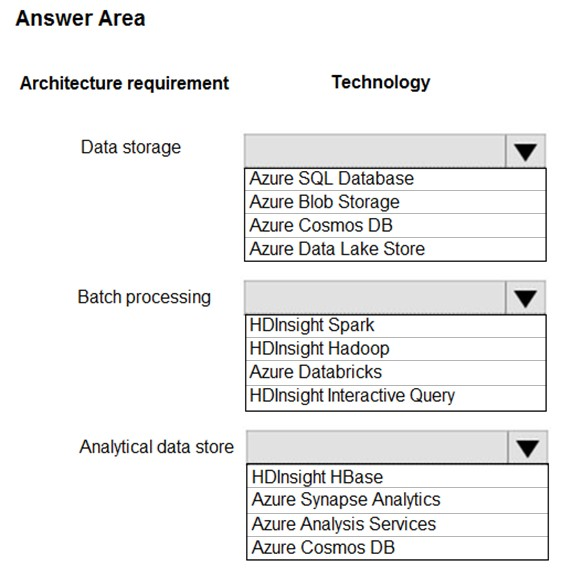
You are developing a solution using a Lambda architecture on Microsoft Azure.
The data at rest layer must meet the following requirements:
Data storage:
✑ Serve as a repository for high volumes of large files in various formats.
✑ Implement optimized storage for big data analytics workloads.
✑ Ensure that data can be organized using a hierarchical structure.
Batch processing:
✑ Use a managed solution for in-memory computation processing.
✑ Natively support Scala, Python, and R programming languages.
✑ Provide the ability to resize and terminate the cluster automatically.
Analytical data store:
✑ Support parallel processing.
✑ Use columnar storage.
✑ Support SQL-based languages.
You need to identify the correct technologies to build the Lambda architecture.
Which technologies should you use? To answer, select the appropriate options in the answer area.
NOTE: Each correct selection is worth one point.
Hot Area:

Correct Answer:
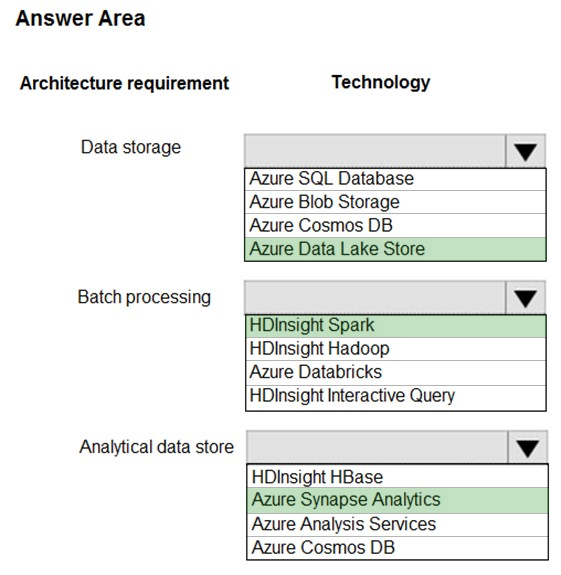
Data storage: Azure Data Lake Store
A key mechanism that allows Azure Data Lake Storage Gen2 to provide file system performance at object storage scale and prices is the addition of a hierarchical namespace. This allows the collection of objects/files within an account to be organized into a hierarchy of directories and nested subdirectories in the same way that the file system on your computer is organized. With the hierarchical namespace enabled, a storage account becomes capable of providing the scalability and cost-effectiveness of object storage, with file system semantics that are familiar to analytics engines and frameworks.
Batch processing: HD Insight Spark
Aparch Spark is an open-source, parallel-processing framework that supports in-memory processing to boost the performance of big-data analysis applications.
HDInsight is a managed Hadoop service. Use it deploy and manage Hadoop clusters in Azure. For batch processing, you can use Spark, Hive, Hive LLAP,
MapReduce.
Languages: R, Python, Java, Scala, SQL
Analytic data store: Azure Synapse Analytics
Azure Synapse Analytics Warehouse is a cloud-based Enterprise Data Warehouse (EDW) that uses Massively Parallel Processing (MPP).
Azure Synapse Analytics stores data into relational tables with columnar storage.
Note: As of November 2019, Azure SQL Data Warehouse is now Azure Synapse Analytics.
References:
https://docs.microsoft.com/en-us/azure/storage/blobs/data-lake-storage-namespace https://docs.microsoft.com/en-us/azure/architecture/data-guide/technology-choices/batch-processing https://docs.microsoft.com/en-us/azure/sql-data-warehouse/sql-data-warehouse-overview-what-is

Data storage: Azure Data Lake Store
A key mechanism that allows Azure Data Lake Storage Gen2 to provide file system performance at object storage scale and prices is the addition of a hierarchical namespace. This allows the collection of objects/files within an account to be organized into a hierarchy of directories and nested subdirectories in the same way that the file system on your computer is organized. With the hierarchical namespace enabled, a storage account becomes capable of providing the scalability and cost-effectiveness of object storage, with file system semantics that are familiar to analytics engines and frameworks.
Batch processing: HD Insight Spark
Aparch Spark is an open-source, parallel-processing framework that supports in-memory processing to boost the performance of big-data analysis applications.
HDInsight is a managed Hadoop service. Use it deploy and manage Hadoop clusters in Azure. For batch processing, you can use Spark, Hive, Hive LLAP,
MapReduce.
Languages: R, Python, Java, Scala, SQL
Analytic data store: Azure Synapse Analytics
Azure Synapse Analytics Warehouse is a cloud-based Enterprise Data Warehouse (EDW) that uses Massively Parallel Processing (MPP).
Azure Synapse Analytics stores data into relational tables with columnar storage.
Note: As of November 2019, Azure SQL Data Warehouse is now Azure Synapse Analytics.
References:
https://docs.microsoft.com/en-us/azure/storage/blobs/data-lake-storage-namespace https://docs.microsoft.com/en-us/azure/architecture/data-guide/technology-choices/batch-processing https://docs.microsoft.com/en-us/azure/sql-data-warehouse/sql-data-warehouse-overview-what-is
send
light_mode
delete
Question #20
DRAG DROP -
Your company has an on-premises Microsoft SQL Server instance.
The data engineering team plans to implement a process that copies data from the SQL Server instance to Azure Blob storage once a day. The process must orchestrate and manage the data lifecycle.
You need to create Azure Data Factory to connect to the SQL Server instance.
Which three actions should you perform in sequence? To answer, move the appropriate actions from the list of actions to the answer area and arrange them in the correct order.
Select and Place:
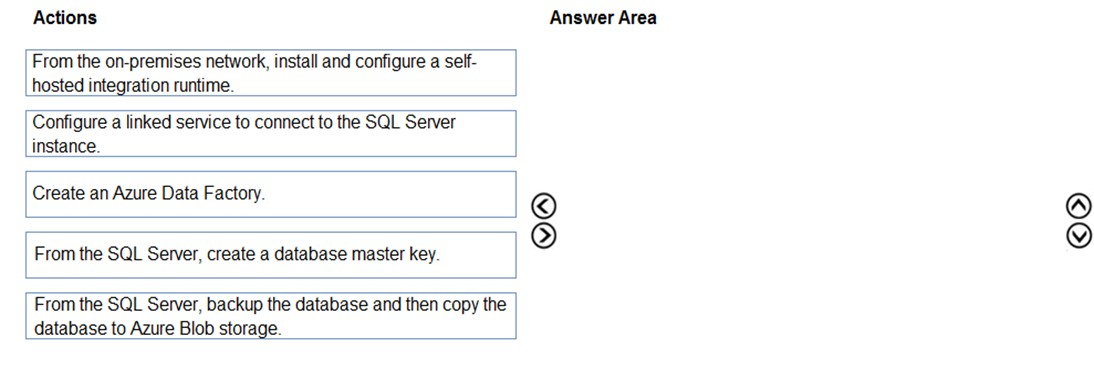
Your company has an on-premises Microsoft SQL Server instance.
The data engineering team plans to implement a process that copies data from the SQL Server instance to Azure Blob storage once a day. The process must orchestrate and manage the data lifecycle.
You need to create Azure Data Factory to connect to the SQL Server instance.
Which three actions should you perform in sequence? To answer, move the appropriate actions from the list of actions to the answer area and arrange them in the correct order.
Select and Place:

Correct Answer:

Step 1: Create an Azure Data Factory
You need to create a data factory and start the Data Factory UI to create a pipeline in the data factory.
Step 2: From the on-premises network, install and configure a self-hosted runtime.
To use copy data from a SQL Server database that isn't publicly accessible, you need to set up a self-hosted integration runtime.
Step 3: Configure a linked service to connect to the SQL Server instance.
Reference:
https://docs.microsoft.com/en-us/azure/data-factory/connector-sql-server https://www.mssqltips.com/sqlservertip/5812/connect-to-onpremises-data-in-azure-data-factory-with-the-selfhosted-integration-runtime--part-1/

Step 1: Create an Azure Data Factory
You need to create a data factory and start the Data Factory UI to create a pipeline in the data factory.
Step 2: From the on-premises network, install and configure a self-hosted runtime.
To use copy data from a SQL Server database that isn't publicly accessible, you need to set up a self-hosted integration runtime.
Step 3: Configure a linked service to connect to the SQL Server instance.
Reference:
https://docs.microsoft.com/en-us/azure/data-factory/connector-sql-server https://www.mssqltips.com/sqlservertip/5812/connect-to-onpremises-data-in-azure-data-factory-with-the-selfhosted-integration-runtime--part-1/
send
light_mode
delete
All Pages
